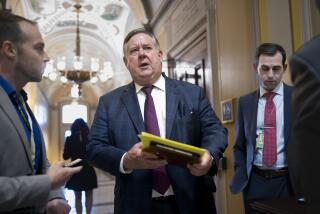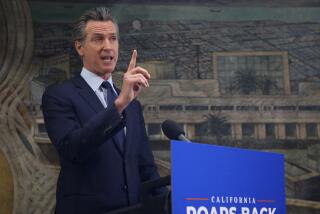White House posts earmarks on website
WASHINGTON — In a direct challenge to Congress and the way it does business, the White House on Wednesday unveiled an online list of all the pet spending projects lawmakers tucked in the federal budget for the 2004-05 fiscal year.
The Internet database details spending known as earmarks, funds that lawmakers funnel to projects, programs and sometimes even specific recipients without going through the normal budget review -- such as the $25 million provided to California spinach farmers in the recent Iraq spending bill.
The amount of earmarked money has tripled in the last decade. And in early January, just as Democrats were taking power, President Bush challenged Congress to halve the number and amount of earmarks, from a record $19 billion in fiscal 2005.
“You didn’t vote them into law. I didn’t sign them into law. Yet they are treated as if they have the force of law,” Bush said in his State of the Union address. “The time has come to end this practice.”
The database, which allows the public to search for earmarks by state and by agency but not by name of the sponsoring lawmaker, is the most comprehensive list produced by the government. But Democrats pointed out Wednesday that it did not include the earmarks the president and his administration requested.
The list includes 13,496 earmarks, of which 1,182 went to California recipients for a total of $1.7 billion, the most of any state.
Beneficiaries included Los Angeles-based nonprofit companies -- such as Fashion Business Inc. ($50,000 for workforce training) and the Jewish Vocational Service ($198,000 to train certified nursing assistants) -- and Arcata-based Internews Network, which got nearly $8 million, mostly for training Indonesian journalists.
Other top recipients included Alaska, which got earmarks for agricultural research on northern climate crops ($1.6 million) and seafood waste ($1.2 million).
The website is the latest effort on both ends of Pennsylvania Avenue to shine light into the hidden realm of earmarks. For years, a few lone congressional protesters -- Arizona Republicans Sen. John McCain and Rep. Jeff Flake to name two -- attempted to halt the rampant growth of earmarks, which soared during the years Republicans were in control of Congress.
Members of both parties defend earmarking as a way for Congress to put attention on local concerns when executive-branch agencies are unresponsive. They are also important to congressional leaders in building their power as well as luring campaign contributions.
But in 2005, earmarking became a public concern. It emerged at the center of the case against former Rep. Randy “Duke” Cunningham (R-Rancho Santa Fe), now in prison for securing federal funding for individuals who provided him personal benefits.
It was also the basis for much of the wealth amassed by lobbyist Jack Abramoff, who was convicted of bribery and a bogus casino deal. He referred to the House Appropriations Committee as “the favor factory.”
Flake hailed the database as a step forward. “Whenever any members of Congress can basically write a check to a group at home without any real oversight, and when people in Congress basically will look the other way if you’ll offer them the same courtesy when they offer earmarks, you’ll have something ripe for abuse,” Flake said. “We shouldn’t be surprised when we have a Duke Cunningham.”
The congressman, who puts out a weekly e-mail spotlighting the “egregious earmark of the week,” said the database “should help those of us who think this process is really short-circuiting the traditional authorizing, appropriating and oversight function of Congress. I think when taxpayers take a look, they’ll be quite upset at how their dollars are being spent.”
When Democrats took power, House and Senate leaders created rules that will identify sponsors of earmarks and require them to certify that they have no financial interest in the earmark.
“It was a missed opportunity to get rid of earmarks altogether,” said Beth Daley, head of investigations at the Project on Government Oversight, a nonpartisan nonprofit. Daley calls earmarks “the funding stream for the lobbying profession.”
The database, at www.whitehouse.gov/omb, lacks some information considered vital by activists. It is only for fiscal 2005 and does not give the name of the lawmaker behind the earmark.
It also does not include any earmarks requested by the administration. As a result, it contains fewer earmarks than some other sources. For example, the Congressional Research Service found $48 billion in earmarks in its review.
Some of those deficiencies will be addressed next year when congressionally authorized earmark disclosure data are released.
“This is a treasure trove of information that [the Office of Management and Budget] has made available to the public,” said Steve Ellis, a vice president of Taxpayers for Common Sense, a group that developed its own earmark database in years past. “We would like to see more, but this is far more than anyone else has had to date.”
*
tom.hamburger@latimes.com
*
Begin text of infobox
Special needs
In fiscal year 2005, there were more than 13,000 earmarks with a total value of $19 billion. Here are the top recipients.
California ... $1.66 (in billions)
Pennsylvania ... 1.09
Virginia ... .94
Texas ... .78
Florida ... .72
*
California projects
About three-fourths of California’s $1.6 billion in earmarks are directed to two areas - defense and transportation. Here is a selection of some of the recipients:
*
Defense
Allied Container Systems
(Pleasant Hill): $29.7 million for range enhancements at Twentynine Palms Marine base
MC Depots
(Barstow): $21.5 million for repairing battle-damaged vehicles
General Atomics-ASI
(Rancho Bernardo): $30 million to acquire two new Predator UAVs
Defense Language Institute
(Monterey): $6.7 million for a dental clinic
*
Transportation
California Department of Transportation: $197,000 for Angels Flight in Los Angeles
L.A. County Metropolitan Transportation Authority: $1.9 million for the MTA bus program
L.A. County MTA: $496,000 for Gold Line subway Foothill extension
Caltrans: $4.2 million for ongoing earthquake retrofit of the Golden Gate Bridge
*
Source: Office of Management and Budget
More to Read
Get the L.A. Times Politics newsletter
Deeply reported insights into legislation, politics and policy from Sacramento, Washington and beyond. In your inbox three times per week.
You may occasionally receive promotional content from the Los Angeles Times.










